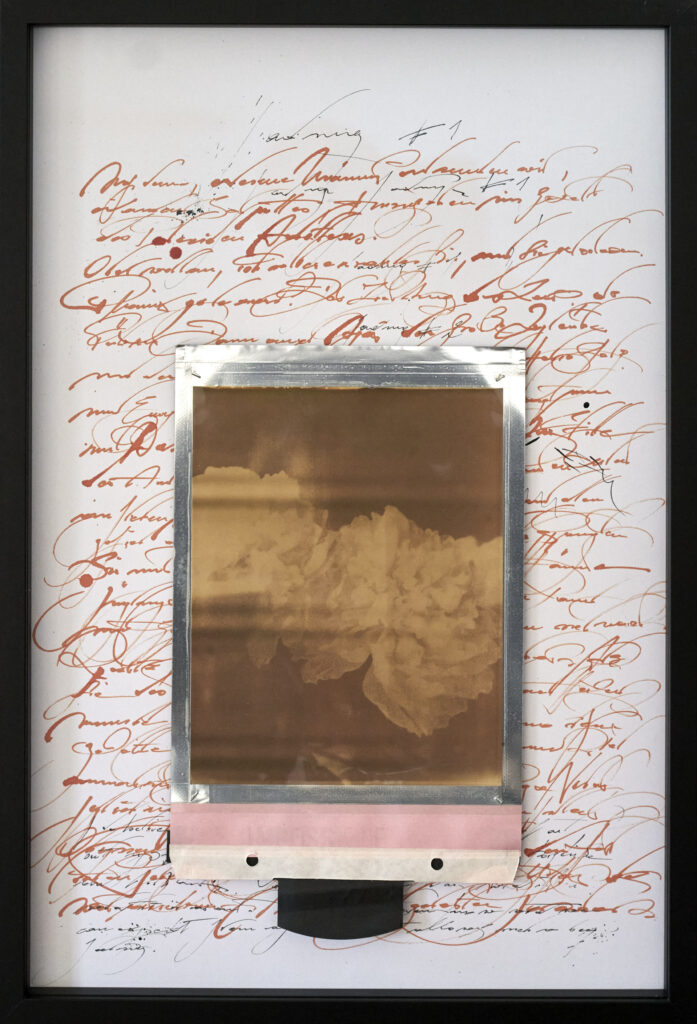‚fading‘ bezieht sich auf fotografische Arbeiten des US-amerikanischen Künstlers Cy Twombly, ist eine Hommage an sein Werk.
Cy Twombly scheint seine Arbeiten ja nie wirklich erklärt zu haben.
Angesprochen darauf, dass seine Werke immer wieder mit mythologischen Themen zu tun haben, hat er angeblich die Bemerkung gemacht, dass alles nur mit Sex zu tun habe.
‚fading‘ refers to photographic works by the US artist Cy Twombly, it is a homage to his work.
Cy Twombly never really seems to have explained his works.
When asked about the fact that his pictures repeatedly have to do with mythological themes, he allegedly made the remark that everything had to do with sex.
Ich habe Cy Twomblys Arbeiten das erste mal 2009 im MUMOK in Wien gesehen.
Den Namen Twombly kannte ich schon vorher, seine Arbeiten waren mir aber nicht geläufig. Twomblys Bilder in natura vor mir zu sehen hat mich ziemlich beeindruckt.
Seine mythologischen Themen, zu denen ich eine starke Affinität habe, haben mich tief berührt, und dann war es diese kindlich anmutende Bearbeitung der Themen in seinen Kritzeleien, in diesen wie Vorstufen zu Schrift anmutenden Übungen, diese Farbflecken – in all seiner künstlerischen Anarchie, die er bis zu seinem Lebensende sogar noch vorangetrieben hat, was auch meine Arbeit nachhaltig beeinflusst.
Seine Fotografien und sein bildhauerisches Werk habe ich erst später kennen und schätzen gelernt, u.a. im Kunsthaus Zürich, wo viele seiner Skulpturen neben Giacomettis frühen Werken ausgestellt waren und sind.
I have seen Cy Twombly’s work for the first time in 2009 at the MUMOK in Vienna.
I knew the name Twombly before, but I was not familiar with his work. Seeing Twombly’s paintings in natura made quite an impression on me.
His mythological themes, for which I have a strong affinity, touched me deeply, and then it was this childlike treatment of the themes in his doodles, in these exercises that seem like precursors to writing, these splashes of colour – all his artistic anarchy, which he even pushed forward until the end of his life, which also has a lasting influence on my work.
I only got to know and appreciate his photographs and his sculptural work later, including at the Kunsthaus Zürich, where many of his sculptures were and are exhibited alongside Giacometti’s early works.
Der chinesische Künstler Tu Hongtao meint zu Twombly: „... Cy Twombly was living in an era that was anti-art, anti-elite. The artist had begun to interfere with society and fight against it. Cy Twombly chose a road completely different from his time and the road of his peers“, und weiter: „… I also asked myself when the new cultura forms of capitalism finally begun to replace the cultural forms of antiquity. Where shall we place time and history? Cy Tombly’s oeuvre indicates a way. In these paintings the classical temperament is fully exposed. Meanwhile, as for paintings, the artist has his own unique and chaotic writing style which let the past, present and future blur. This method of confusing the classical and modern avoids the elite and anti-elite. It avoids a current of one arrogance over another arrogance.“
Die 8 x 10″ (20 x 25 cm) großen Polaroids in der fünfteiligen Serie ‚fading‘ zeigen verfremdete Reproduktionen, Ausschnitte aus verschiedenen Blumenbildern Twomblys, die dieser selber auf Polaroid-Film fotografiert und in einem eher altmodischen Verfahren gedruckt hat. Man mag darin eine Anlehnung an den Pictoralismus erkennen, einer Stilrichtung von Ende des 19. Jahrhunderts bis zum ersten Weltkrieg, die die Fotografie als künstlerisches Ausdrucksmittel benutzte und sie als Kunst etablierte. Charakteristisch dafür sind verschwommene Ansichten, Ausschnitte sowie fließende Übergänge, Elemente, die auch in Twomblys abstrakten malerischen Arbeiten wesentlich sind.
Die Bildträger der hier gezeigten Polaroids aus ‚fading‘ sind mit Texten und Textfragmenten versehen, ein weiterer Bezug zu Twomblys Malereien und Skulpturen, in denen seit den 1960er Jahren Text und Schrift ein wesentliches Element darstellen. Die meisten seiner Werkgruppen beschäftigen sich mit Themen aus der griechischen Mythologie, zu der er auf ausgedehnten Reisen rund um das Mittelmeer gefunden hat, und auf die er immer wieder zurückgreift. Cy Twombly lebte seit Mitte der 1970er Jahre bis zu seinem Tod im Jahr 2011 in Italien.
The 8 x 10″ (20 x 25 cm) Polaroids in the five-part series ‚fading‘ show alienated reproductions, excerpts from various flower pictures by Twombly, which he photographed himself on Polaroid film and printed in a rather old-fashioned process. One might recognise in this a reference to Pictoralism, a style from the end of the 19th century until the First World War, which used photography as a means of artistic expression and established it as art. Characteristic of this are blurred views, cut-outs and flowing transitions, elements that are also essential in Twombly’s abstract painterly works.
The image carriers of the Polaroids from ‚fading‘ shown here are provided with texts and text fragments, another reference to Twombly’s paintings and sculptures, in which text and writing have been an essential element since the 1960s. Most of his work groups deal with themes from Greek mythology, which he found on extensive journeys around the Mediterranean and to which he returns again and again. Cy Twombly lived in Italy from the mid-1970s until his death in 2011.
In ‚fading #4‘ wird Cy Twomblys Zyklus ‚Fifty Days at Iliam‘ aus dem Jahr 1978 zitiert, Elemente aus seinen Bildern sind übernommen worden. Der Bilderzyklus basiert auf Alexander Pope’s Übersetzung der Ilias und erzählt eine Abfolge an Ereignissen auf zehn großformatigen Leinwänden aus Homers Epos über den Trojanischen Krieg.
Der Titel ‚fading‘ (vergehen, verblassen, …) bezieht sich erstens auf diese Vergänglichkeit von Blumen und Blüten, andererseits auf das fotografische Verfahren, mit dem die Fotografien Twomblys verfremdet wurden – ein Polaroid-Bild hat die Tendenz, seine Anmutung mit der Zeit zu verändern, ja zu verblassen, wenn die Bilder nicht vor ultraviolettem Licht geschützt werden.
In ‚fading #4‘ Cy Twombly’s cycle ‚Fifty Days at Iliam‘ from 1978 is quoted, elements from his paintings have been adopted. The cycle of paintings is based on Alexander Pope’s translation of the Iliad and narrates a sequence of events on ten large-format canvases from Homer’s epic poem about the Trojan War.
The title ‚fading‘ refers firstly to this transience of flowers and blossoms, and secondly to the photographic process with which Twombly’s photographs were alienated – a Polaroid image has a tendency to change its appearance over time, indeed to fade, if the images are not protected from sunlight.
Cy Twombly (Edwin Parker Twombly jr.)
* 1928 in Lexington / Virginia, USA
+ 2011 in Rom, Italien
war ein US-amerikanischer Maler, Fotograf und Objektkünstler, und zählt zu den wichtigsten Vertretern des abstrakten Expressionismus.
Cy Twombly (Edwin Parker Twombly jr.)
* 1928 in Lexington / Virginia, USA
+ 2011 in Rome, Italiy
was an American painter, photographer and object artist, and is one of the most important representatives of abstract expressionism.
(Text: Herwig Prammer, 2022)
fading #1 to fading #5, 2021
8×10“ Polaroid, ink and graphit on paper, glass frame
62 x 42,5 cm
fading #1
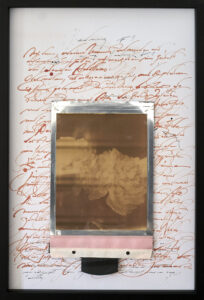
Neben unzusammenhängenden Textfragmenten um die Arbeiten von Cy Twombly ist ein Auszug aus dem neunten Gesang der Ilias auf das Trägerblatt geschrieben, eine Szene, in der die Gesandten Agamemnons, u.a. Odysseus, sich auf den Weg zu Achill machen, ihn zu bewegen, wieder am Kampf teilzunehmen.
Alongside disjointed fragments of text surrounding the works of Cy Twombly, an excerpt from the ninth canto of the Iliad is written on the backing sheet, a scene in which Agamemnon’s envoys, including Odysseus, set out to persuade Achilles to rejoin the battle.
fading #2
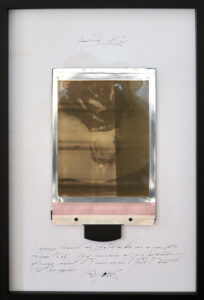
Zitat der Fotografin Diane Arbus: Quote from photographer Diane Arbus:
‚I always thought of photography as a naughty thing to do – that was one of my favourite things about it, and when I first did it, I felt very perverse.‘
fading #3
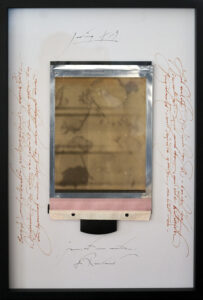
neben einem Zitat Arthur Rimbauds – ‚Je est un autre.‘ (ich ist jemand anders) wird ein Auszug eines Essays von Ronland Barthes mit dem Titel ‚Die Weisheit der Kunst‘ zitiert.
next to a quotation from Arthur Rimbaud – ‚Je est un autre.‘ (I am someone else), an excerpt from an essay by Ronland Barthes entitled ‚The Wisdom of Art‘ is quoted.
fading # 4
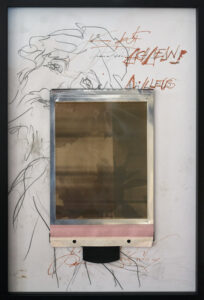
Bleistift, Textornamente und Worte aus Werken Cy Twomblys.
Die Schriftzüge ‚ACHAEANS‘ und ‚ACHILLEO / ACHILLEUS‘ sind nicht nur inhaltliche, sonder auch Bildliche Zitate.
Pencil, text ornaments and words from Cy Twombly’s works.
The lettering ‚ACHAEANS‘ and ‚ACHILLEO / ACHILLEUS‘ are not only quotations of content but also of image.
fading #5

über einem Textfragment aus Cy Twomblys Werk steht in rot ein Zitat des Lyrikers Wallace Stevens geschrieben, dessen Werke auf Cy Twombly Einfluss hatten,
die Titel eines dreiteiligen Gedichts:
It must be abstract
It must change
It must give pleasure
above a text fragment from Cy Twombly’s work is written in red a quotation from the poet Wallace Stevens, whose works had an influence on Cy Twombly,
the title of a three-part poem:
It must be abstract
It must change
It must give pleasure
Homepage Herwig Prammer: www.prammer.com
ip.forum | exhibition | Herwig Prammer, 42, March 11 – July 31, 2021
post on our blog:
Herwig Prammer: … Odysseus war ein Arsch | … Ulysses was a prick
Herwig Prammer: Hasenjagd, Kapitel IV | Hare hunt, chapter IV
